Bahn storming: Germany’s industrial landscapes are still shaped by the automobile
The country’s big players are racing to stay ahead of the pack
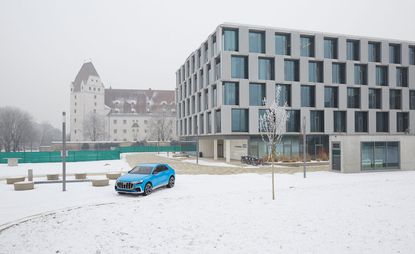
Audi Q8, Ingolstadt
Audi’s Q8 concept exemplifies the Ingolstadt-based company’s next-generation luxury crossover. The backdrop is Audi’s new Academy building, opened as a training centre in Ingolstadt in 2015. As the brand’s traditional home, the city hosts around 40,000 workers and Audi’s largest factory (the second largest car plant in Europe), while the public face of the brand is the glass-walled Audi Forum museum. Buyers will soon be able to slip inside their very own Q8, which is due in showrooms in 2018. Sleeker than your average SUV, the model is the flag-bearer for Audi’s burgeoning electric-drive and autonomous technologies, alongside the dedicated all-electric e-tron model that the company hopes, will make it an EV class leader within a few years.
Audi Q8, on sale in 2018. For more information, visit the Audi website
BMW 530d xDrive, Munich
The swoops and curves of Coop Himmelb(l)au’s spectacular BMW Welt stand in stark contrast to the conservative simplicity of the new BMW 5 Series. That’s not to say that the 5 Series is prosaic. The model has a well-deserved reputation as the most aspirational choice for corporate types, mainly because BMW uses it as a showcase for all the interesting things you can do with a conventional car. The current model, codenamed G30, is the seventh generation of the car that ushered in BMW’s current nomenclature back in 1972. Today’s 530d xDrive is a rocketship for the ambitious executive, stuffed full of quasi-autonomous tech and the design confidence, inside and out, that BMW has made its own. Bavarian Motor Works doesn’t do things by halves – it’s one of the most avant-garde mass-market manufacturers in the world, as its architectural commissions testify.
BMW 530d xDrive. From £30,405, for more information, visit the BMW website
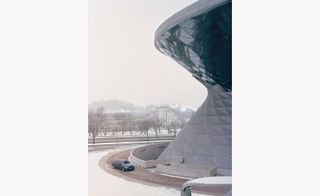
Porsche Panamera 4 E-Hybrid, Stuttgart
Although Porsche has five other facilities, including an R&D centre at Weissach and another major production hub in Leipzig, the historic association with Stuttgart makes it the brand’s spiritual home. Ferdinand Porsche began working in the city in the early 1930s, but the first true Porsche factory opened in Stuttgart’s northern Zuffenhausen district in 1952, on what is now called Porschestrasse. Today, the brick-built structure is hemmed in by relentless and ongoing expansion, including Delugan Meissl’s striking 2009 Porsche Museum (in the background). Porsche Panamera 4 E-Hybrid, Stuttgart The Panamera is now in its second generation, with the blunt edges of this big four-door sports saloon chiselled off to reveal something really rather handsome. Its low-slung bodywork hides a hybrid powertrain that allows for purely electric pottering as well as ferocious Autobahn storming. With an even swifter hybrid variant waiting in the wings, alongside the stretched ‘Executive’ version and a ‘shooting brake’-style estate, the Panamera has become one of the world’s most seductive saloons.
Porsche Panamera 4 E-Hybrid, from £79,715. For more information, visit the Porsche website

W Atlas, Wolfsburg
The chimneys of the Wolfsburg North power plant tower over a 5 sq km fiefdom dedicated entirely to the car. The Atlas illustrates just how far VW has come since its days of manufacturing a single model designed to suit all purposes. This ‘full-size’ SUV, 5m long and with seven seats, is pitched primarily at the all-important American and Chinese markets, and a hybrid version is in the offing. If long-term plans aren’t frustrated by political chicanery, VW’s aim is to lead the way in mass-market electric cars, sharing tech and expertise developed by sister companies Porsche and Audi.
VW Atlas, on sale summer 2017. For more information, visit the Volkswagen website
As originally featured in the April 2017 issue of Wallpaper* (W*217). Friend

Wallpaper* Newsletter
Receive our daily digest of inspiration, escapism and design stories from around the world direct to your inbox
Jonathan Bell has written for Wallpaper* magazine since 1999, covering everything from architecture and transport design to books, tech and graphic design. He is now the magazine’s Transport and Technology Editor. Jonathan has written and edited 15 books, including Concept Car Design, 21st Century House, and The New Modern House. He is also the host of Wallpaper’s first podcast.
-
 Bang & Olufsen’s Recreated Classics series continues with a CD player revival
Bang & Olufsen’s Recreated Classics series continues with a CD player revivalBang & Olufsen’s Beosystem 9000c music system brings the original digital compact disc format back to life and pairs it with the latest in speaker design
By Jonathan Bell Published
-
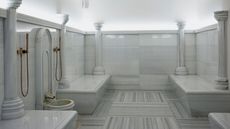 A new book highlights the work of Turkish interior designer Zeynep Fadıllıoğlu
A new book highlights the work of Turkish interior designer Zeynep Fadıllıoğlu‘Zeynep Fadıllıoğlu: Luxury Redefined’, published by Rizzoli, traces the career of leading Istanbul-based designer Zeynep Fadillioglu, the first woman to design a mosque in Turkey
By Léa Teuscher Published
-
 London gallery Incubator’s six emerging artists to see in spring 2024
London gallery Incubator’s six emerging artists to see in spring 2024Incubator's spring programme features six artists in consecutive two-week solo shows at the London, Chiltern Street gallery
By Mary Cleary Published
-
 BMW Vision Neue Klasse X reveals the shape of tomorrow’s electric SUV
BMW Vision Neue Klasse X reveals the shape of tomorrow’s electric SUVNew concept the BMW Vision Neue Klasse X previews the next-generation ‘X’ models
By Jonathan Bell Published
-
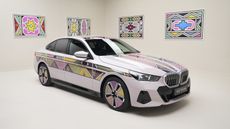 BMW i5 Flow NOSTOKANA brings Esther Mahlangu’s art to life at Frieze LA
BMW i5 Flow NOSTOKANA brings Esther Mahlangu’s art to life at Frieze LABMW’s Art Car Project has rarely impacted on the company’s everyday business of building cars. With the BMW i5 Flow NOSTOKANA, could all that be about to change?
By Jonathan Bell Published
-
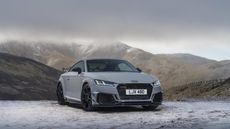 Farewell to the Audi TT, a design icon that evolved with the automotive landscape
Farewell to the Audi TT, a design icon that evolved with the automotive landscapeFor over 25 years, the Audi TT has been synonymous with the brand, a modern machine that initially favoured style over sport. The final editions are very different beasts to the original
By Jonathan Bell Published
-
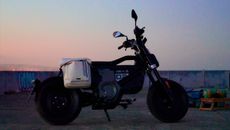 Electric BMW CE 02 is an eParkourer for the urban jungle
Electric BMW CE 02 is an eParkourer for the urban jungleThe BMW CE 02 – BMW Motorrad’s second all-electric scooter –is aimed squarely at the urban rider, offering style and power in a bold new package
By George Chapman Published
-
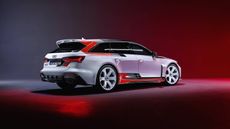 Audi RS6 Avant GT is an estate car that thinks it belongs on the track
Audi RS6 Avant GT is an estate car that thinks it belongs on the trackWith the Audi RS6 Avant GT limited-edition supercar, Audi Sport has gone all-out to create the ultimate hyper-estate
By Jonathan Bell Published
-
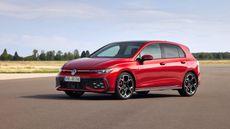 VW Golf at 50: the new model, and a look back at the pioneering small car
VW Golf at 50: the new model, and a look back at the pioneering small carA VW Golf update brings new tech, innovations and efficiencies to keep the car at the heart of the brand 50 years after its debut
By Jonathan Bell Published
-
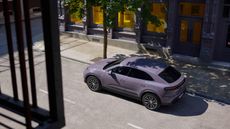 Porsche transforms the Macan into its newest all-electric model
Porsche transforms the Macan into its newest all-electric modelThe new Porsche Macan 4 and Macan Turbo are compact electric SUVs that mark a major step in the company’s transformation into a luxury EV maker
By Jonathan Bell Published
-
 CES 2024 was a showcase for how to shoehorn AI into next-generation cars
CES 2024 was a showcase for how to shoehorn AI into next-generation carsCES 2024 in Las Vegas underlined that future mobility will be shaped by AI, like it or not, as intelligent assistants emerge to guide, plan and converse with their human cargo
By Jonathan Bell Published